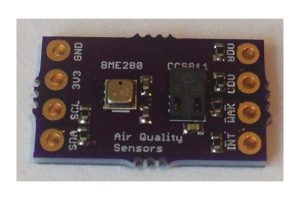What is it?
This is a small (17.9 mm x 10.3 mm) breakout board with Bosch’s BME280 pressure, temperature, and humidity sensor as well as AMS’ CCS811 digital gas sensor. The sensors work in concert to provide a complete measurement via I2C register reads of indoor air quality including temperature- and humidity-compensated estimates of equivalent CO2 concentration in parts per million (400 – 8192 ppm) and volatile organic chemical concentration in parts per billion (0 – 1187 ppb).
The breakout provides access to the enable and interrupt pins of the CCS811 (pulled HIGH by 10 K pullups since these are active LOW) for proper sensor management as well as the I2C address pins (BDO for the BMP280 and CDO for the CCS811, pulled LOW by 10 K pulldowns for default I2C addresses 0x76 and 0x5A, respectively) for each sensor so more than one of these boards can be placed on the same I2C bus for wider area coverage. The breakout board is designed to operate on 3V3 power and can be used with almost any 3V3-compatible MCU with at least one I2C bus. This is the one I use. There are 4K7 pullups on the board that support I2C bus speeds of up to 400 kHz.
Why did you make it?
Environmental sensing is a useful capability especially in a small, low-power package that can be mounted virtually anywhere. When coupled with a wifi- or BLE-enabled MCU this air quality breakout board provides a means for remote environmental sensing of any indoor and many outdoor spaces. The sensor sample rates and operation modes can be configured for a wide range of duty cycles so the user can strike the right balance between power usage and frequency of data update. Running the breakout with the CCS811 updating every ten seconds uses a few mA (the BME280 is a very low power sensor consuming 10s of uA) so this air quality sensor could last for days even on a small battery. At the available 60 second update rate this air quality sensor could last for weeks.
What makes it special?
This is a very small breakout that exposes all functionality of the BME280 and CCS811 air quality sensors to provide an accurate estimate of the condition of any indoor space and even many outdoor spaces. It doesn’t measure everything, and cannot identify the concentrations of specific chemical pollutants in the air; it returns equivalent eCO2 and VOC concentration estimates based on calibration with typical indoor environments. So the concentrations are indicative and best used in a relative sense. For example, at rest on my desk indoors the eCO2 reading is usually 400 ppm and the VOC is usually 0 ppb. However, if my breath happens to pass close to the sensor while I am working I see the eCO2 rise to ~1000 ppm and the VOC rise to ~20 ppb, etc. The sensor can easily detect when I breathe nearby and can measure about how close I am by the size of the excursion. The values quickly return to “normal” when I move away from the sensor.
Read more: Air Quality Sensors on tindie.com

